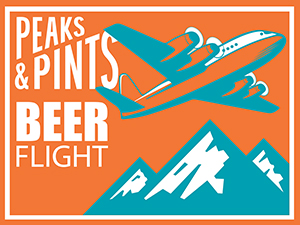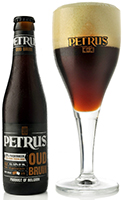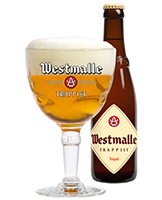 Belgium looks like a film set for some massive historical costume drama. Belgium boasts more castles than any other place on earth, and Belgians earn most of their money by charging tourists to walk up those tall towers — and then amuse themselves by making fun of the fat, exhausted bastards. Of course, they once had a king named Clovis, so Peaks and Pints is pretty sure those bastards have been making fun of Belgians for that (and other things) forever. Belgians make a lot of chocolate. Some people think it is the best chocolate in the world. Those people are idiots. Belgians also make a lot of beer. A lot of beer. And some people think that the Trappist ales coming out of Belgium are the best beers in the world. Those people are not idiots. National Belgian Beer Week kicked off July 14 and runs through July 21. Peaks and Pints is throwing a huge Belgian Beer Week Finale celebration Friday, July 21. In the meantime, we present a flight of Blegian beers we like to call Craft Beer Crosscut 7.17.17: A Flight of National Belgian Beer Week.
Belgium looks like a film set for some massive historical costume drama. Belgium boasts more castles than any other place on earth, and Belgians earn most of their money by charging tourists to walk up those tall towers — and then amuse themselves by making fun of the fat, exhausted bastards. Of course, they once had a king named Clovis, so Peaks and Pints is pretty sure those bastards have been making fun of Belgians for that (and other things) forever. Belgians make a lot of chocolate. Some people think it is the best chocolate in the world. Those people are idiots. Belgians also make a lot of beer. A lot of beer. And some people think that the Trappist ales coming out of Belgium are the best beers in the world. Those people are not idiots. National Belgian Beer Week kicked off July 14 and runs through July 21. Peaks and Pints is throwing a huge Belgian Beer Week Finale celebration Friday, July 21. In the meantime, we present a flight of Blegian beers we like to call Craft Beer Crosscut 7.17.17: A Flight of National Belgian Beer Week.
 Lindemans Kriek
Lindemans Kriek
3.5% ABV
Lambics are sharp, acidic, and fruity. They can be compared to yogurt or vinegar but with hints of sweetness. There are also several sub-styles of lambics. Lindemans has been brewing lambic since 1811. They were the first to introduce lambics to the American market (in 1979) and have remained the most popular brand. While they also make a peach, raspberry and pear lambic, the cherry is their most traditional flavor. Whole fresh cherries are added to the casks, triggering a third fermentation and promoting a spritz-y carbonation that gives the finished beer a champagne-like character with excellent mouthfeel. The flavor is akin to a natural black cherry soda, having a dark sweetness with only a flash of malty bitterness.
 Petrus Oud Bruin
Petrus Oud Bruin
5.5% ABV, 17 IBU
Oud bruins are similar to Flanders red ales, but tend to be a bit less tart, with additional darker fruit flavors such as figs, raisins or prunes. The malt is darker than the Flanders red ale and should taste of caramel, toffee, or chocolate. Like the red ale, Flanders brown ales are sour, but should not be acetic or vinegary. Petrus Oud Bruin’s flavor is simple and not jarring, particularly appealing to those making a first sojourn in this style: There’s a rush of syrupy cherry sweetness, followed quickly by soft acidic sourness and woody oak notes like those in red wine. Oud Bruin finishes remarkably dry, with a tart quality that lasts well into the aftertaste.
 Dupont Avec Les Bons Voeux
Dupont Avec Les Bons Voeux
9.5% ABV, 28 IBU
In January 1970, Belgian brewery Brasserie Dupont needed a gift to dole out to key clients. Key chains just weren’t going to cut it. Since the brewery produces amazing ales they thought why not gift an ale: Avec Les Bons Voeux, which translates as “with best wishes.” It blew minds. Dupont eventually released it commercially, albeit in limited quantities. A blond ale boasting a hefty 9.5-per-cent alcohol, it pours with a hazy tint and is almost buttery-smooth in texture. There’s mellow fruitiness and yeasty bread flavor at its core, with lively clove and licorice notes folded in, set against a solidly bitter backbone.
 Rodenbach Grand Cru
Rodenbach Grand Cru
6% ABV, 35 IBU
Flanders red ale is a style of sour ale brewed in West Flanders, Belgium. Flanders red ale is aged in oak barrels with Lactobacillus and Brettanomyces that add yogurt tang and barnyard notes and Acetobacter, which is the bacteria that creates vinegar. Consequently, Flanders red ales have sharp acidic, vinegar notes. Coming out of west Flanders is the World Beer Cup gold medal-winning Rodenbach Grand Cru, a blend of “young” beer (33%) and an older beer (67%) that has matured in oak vats. It is the high percentage of the older ripened-in-oak beer that gives it the complex and intense bouquet with a very long aftertaste like a Grand Cru wine. The late Michael Jackson bestowed upon this beer the titles of “World Classic” and “the Burgundy of Belgium.
 Brouwerij der Trappisten van Westmalle Tripel
Brouwerij der Trappisten van Westmalle Tripel
9.5% ABV, 36 IBU
In 1836 the Belgian Westmalle monastery became a Trappist Abbey and began brewing beer shortly thereafter. The holy suds they produced started out as an insider-only deal — a choice beverage to be made and enjoyed by Trappists and Trappists alone, but eventually they decided to expand and opened up a public beer hall in the early 1930s. Westmalle embodies the tripel style with a thoughtful balance of sweet, fresh pear, lemon zest and a dash of peppery spice. Its flirtatious effervescence sweeps the mouth clean, while lingering lemony hops leave the mouth pining for more. It’s an exceptional beer, with a great deal of finesse and elegance and a splendid enduring aftertaste.
